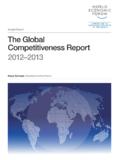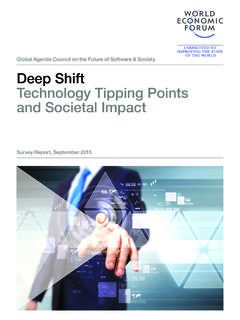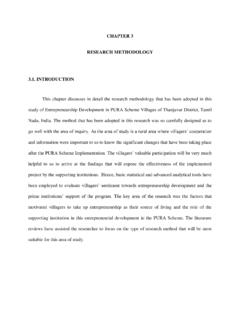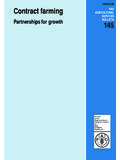Transcription of Growth Poles: Raising Competitiveness and …
1 The Africa Competitiveness Report 2013 | 93 chapter Poles: Raising Competitiveness and deepening regional IntegrationJOHN SPEAKMANMARJO KOIVISTOW orld BankAlthough some of Africa s improved economic performance in the past decade has already been driven by improvements in infrastructure, critical investment and policy coordination challenges remain. As the previous chapters have highlighted, the balance for Growth and Competitiveness is likely to come from structural changes such as (1) reducing costs for building infrastructure; (2) locking in investors from both public and private sectors as risk sharers; and (3) incentivizing the participation, particularly of the local private sector, in these Furthermore, Africa s competitive industries such as agriculture, mining, and tourism carry vast potential, and they require sustained support if they are to deliver on the promise of comprehensive Competitiveness and economic the efforts of regional organizations to overcome barriers to trade in products and services, Competitiveness continues to be constrained by infrastructure deficits, red tape and slow decision making, difficulty in securing and accessing serviced industrial land, and information failures that prevent the private sector from coordinating investment activity.
2 Growth poles, typically multi-year, public-private investments, are emerging as a key instrument to overcome barriers to investment and to support the agglomeration of economic poles are simultaneous, coordinated investments in many sectors to support self-sustaining industrialization in a country. They bear resemblance to, but are not the same as, special economic zones (SEZs), which are spatially delimited areas within an economy. Examples include export processing zones, economic processing zones, free zones, and foreign trade SEZs, as supply-side Competitiveness measures, are aimed at overcoming barriers that hinder investment in the wider economy, including restrictive policies, poor governance, inadequate infrastructure, and problematic access to land.
3 Growth poles, on the other hand, usually combine public and private investments and are specifically built around an already-existing resource at a specific location in an to the Growth pole is a group of dynamic industries connected around a particular resource. These industries are, by virtue of their dimension or negotiation strength, anticipated to have the capacity to innovate and adapt to market conditions. The Growth of dynamic industries is anticipated to generate further investment, employment, and distribution of factor payments, including profits that may be reinvested. The Growth of dominant industries, in turn, generates external effects that stimulate the Growth of other industries due to inter-industry contribution of Julien Szabla to the preparation of materials for this chapter is gratefully acknowledged.
4 @ 2013 World Economic : Growth Poles94 | The Africa Competitiveness Report 2013 This chapter will draw from the World Bank s quite significant experience in supporting the development of Growth poles in Africa in recent decades. Good-practice lessons also emerge from Asia, where, for example, the Growth poles in Malaysia and Indonesia benefited from investments made through ASEAN regional integration This chapter explains the idea behind Growth poles in more detail and outlines how they interact with infrastructure investments, trade, and regional integration . It also discusses particular examples of Growth poles in Africa and the benefits, challenges, and potential pitfalls of making Growth pole investments.
5 The chapter then outlines the key policy challenges involved with Growth poles and, finally, addresses Growth pole the first part of the chapter explains, the underlying assumption about the benefits of Growth poles is that they increase market size so that it becomes profitable for firms to invest. Private-sector investments, in turn, lead to more jobs, higher wages, and economies of scale. Growth pole projects also often attract foreign direct investment (FDI), are built across borders, and have spillover effects beyond national economies. Thus they can also be a boon to regional number of challenges characterize Growth pole projects. To set a framework for policymakers to plot the course for Growth poles to enhance Competitiveness , the chapter next discusses three key policy challenges: Growth pole coordination challenges concern the setting up and sustaining of both the spatial and the political economy linkages that are required to make these poles happen.
6 Tradeoffs and the strategic vision are both required in multi-stakeholder investments and projects such as infrastructure ones, and both need be focused on ensuring that participation is balanced and sustained throughout the process. Accountability questions concern the push and pull of rewards embedded in the contracts stakeholders make to design and deliver Growth pole projects. The key accountability challenges regarding Growth poles in Africa today concern the returns of these investments to landlocked countries and coastal countries, as well as to rural and urban populations. Accountability questions also concern the socioeconomic sustainability that Growth pole investments can promote across the investment area and industries.
7 Risk management and risk sharing concern the endeavors that are put in place to make risks and rewards commensurate with each other to drive good performance as the Growth pole is built, managed, and , the chapter discusses the specific type of investment arrangements that can significantly improve benefits to be realized from Growth poles. Experience in Growth pole engagements shows that both public and private participation is required to realize results. For example, public-private partnerships (PPPs) for constructing and maintaining infrastructure will broaden the possibilities for private-sector job creation around Growth pole projects. Although there is no fixed list of best-practice policies to realize private-sector development objectives from Growth poles, and specific related reforms will vary by sector, Growth poles show why effective investment and particularly policy-process coordination will make infrastructure projects more POLES FOR SHARING PROSPERITY IN AFRICA S MARKETSThe Growth pole approach to economic development looks at how infrastructure that will be developed for an existing private investment in mining, agriculture, and so on can be used to encourage spillovers into other sectors.
8 This could manifest itself through a development corridor or a special economic zone, or even an agglomeration economy in a booming city. A Growth pole will have an existing resource that serves as an inherent revenue are Growth poles? Growth poles, as noted earlier, are comprised of multiple simultaneous investments coordinated throughout many sectors with the purpose of supporting self-sustaining industrialization in a country. Growth pole projects are not oriented around addressing identified market failures, but around capitalizing on and augmenting opportunities that already exist in an economy, as Figure 1, illustrating the dynamics of building Growth poles, 1 shows how Growth poles enhance already-existing opportunities and can multiply them over time, delivering both quick wins and generating medium- and long-term investments.
9 Indeed, the underlying assumption about the benefits of Growth poles is that they increase market size so that it becomes profitable for firms to invest, with the resulting higher wages and economies of scale. If an investment in a project induces investment in the following stages of production, it is called forward linkage and has outcomes such as diversification in value chains. A backward linkage is a creation of investment in the stages of production leading up to the final product, such as investment into logistics or the storing of goods. Investment should be pushed into a project that maintains the highest number of total linkage , Growth poles, as economic initiatives, are spatially targeted investment instruments and sets of policy for accelerating economic Growth in developing countries.
10 As a concept, Growth poles are based on Perroux s assumption that, for an economy to attain higher income levels, that economy should first develop within itself one or several regional centers for economic Growth poles, as a spatial planning tool, draw @ 2013 World Economic ForumThe Africa Competitiveness Report 2013 | 95 : Growth Poleson the following concepts: (1) economies of scale, (2) the nurturing of backward and forward economic supply linkages and also fiscal and final demand linkages, and (3) economies of agglomeration, which are associated with spatial clusters and the geographic concentration of economic 2 illustrates how to identify potential Growth poles and shows the specificity of this investment and project development the steps needed to identify Growth poles illustrate, the Growth pole model of economic development is distinct from the development corridor of SEZ investments.

















